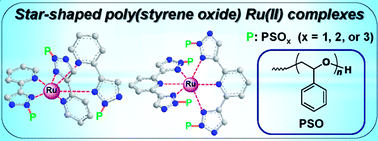Synthesis of 3-, 4-, 5-, 6-, 7-, 8-, 9-, 10-, 11-, and 12-armed star-shaped poly(styrene oxide) Ru(ii) complexes by a click-to-chelate approach†
Abstract
This study describes the first convenient preparation of 3-, 4-, 5-, 6-, 7-, 8-, 9-, 10-, 11-, and 12-armed star-shaped poly(styrene oxide) (PSO) Ru(II) complexes using a click-to-chelate approach. This approach involves the combination of the click reaction and stepwise chelating reactions of Ru(II)(DMSO)4Cl2 with macroligands, 2-(1-PSOn-1,2,3-triazol-4-yl)pyridine (PSOn-tapy) or 2-(1-PSOm-1,2,3-triazol-4-yl)-6-(1-PSOn-1,2,3-triazol-4-yl)pyridine (PSOm-bitapy-PSOn) (m, n = 1, 2, or 3). Click chemistry was used to prepare the PSOn-tapy and PSOm-bitapy-PSOn macroligands. More specifically, PSOn-tapy was prepared by reacting the azido-functionalized PSOn (PSOn-N3) with excess 2-ethynylpridine. On the other hand, PSOm-bitapy-PSOn was obtained by the click reaction of excess PSOn-N3 with 2,6-diethynylpridine to afford (PSOn)2-bitapy when m equals n, and by the stepwise click reactions of PSOm-N3 and PSOn-N3 with 2,6-diethynylpridine to produce PSOm-bitapy-PSOn when m is not equal to n. In order to obtain these polymer-substituted macroligands, PSOn-N3 was initially synthesized by the living ring-opening polymerization (ROP) of styrene oxide (SO) using t-Bu-P4 as a catalyst and the azido-functionalized mono- or multi-hydroxyl compounds, e.g., 6-azido-1-hexanol, 2-((6-azidohexyloxy)methyl)-2-methylpropane-1,3-diol (1) and 2-((6-azidohexyloxy)methyl)-2-(hydroxymethyl)propane-1,3-diol (2) as initiators.


 Please wait while we load your content...
Please wait while we load your content...